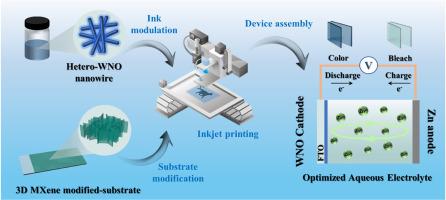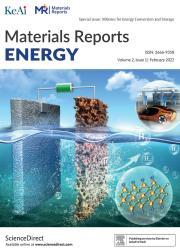Inkjet-printing assisted engineering of patternable zinc anode-based electrochromic devices
IF 13.8
引用次数: 0
Abstract
Zn anode-based electrochromic devices (ZECDs) stand out as a highly promising technology in the upcoming era of multifunctional electronic devices, offering a blend of electrochromic capabilities and energy storage functions within a single transparent platform. However, significant challenges persist in achieving efficient patterning, ensuring long-term stability, and fast color-switching kinetics for these devices. In this study, heterogeneous tungsten oxide nanowires (W17O47/Na0.1WO3, WNOs) are formulated into inkjet printing ink to assemble patternable ZECDs. The heterogeneous electrode structure of WNO enables a highly capacitive-controlled mechanism that promotes fast electrochromic/electrochemical behavior. Notably, by utilizing a three-dimensional MXene mesh modified substrate, the inkjet-printed ZECDs exhibit a wide optical modulation range of 69.13%, rapid color-changing kinetics (tc = 4.1 s, tb = 5.4 s), and highly reversible capacities of 70 mAh cm−2 over 1000 cycles. This scalable strategy develops the patterned electrodes with a wide optical modulation range and substantial energy storage properties, offering promising prospects for their application in next-generation smart electronics.

喷墨印刷辅助设计可图案化锌阳极电致变色器件
在即将到来的多功能电子器件时代,基于锌阳极的电致变色器件(ZECDs)作为一种非常有前途的技术脱颖而出,它在一个透明的平台内提供了电致变色能力和能量存储功能的混合。然而,在实现这些设备的高效图案,确保长期稳定性和快速颜色切换动力学方面仍然存在重大挑战。在本研究中,将非均相氧化钨纳米线(W17O47/Na0.1WO3, WNOs)配制成喷墨油墨来组装可图案化的zecd。WNO的非均相电极结构使其具有高度电容控制机制,促进了快速的电致变色/电化学行为。值得注意的是,通过使用三维MXene网格修饰的衬底,喷墨打印的zecd具有69.13%的宽光学调制范围,快速变色动力学(tc = 4.1 s, tb = 5.4 s),以及超过1000次循环的70 mAh cm - 2的高可逆容量。这种可扩展的策略开发出具有宽光调制范围和大量能量存储特性的图案电极,为其在下一代智能电子产品中的应用提供了广阔的前景。
本文章由计算机程序翻译,如有差异,请以英文原文为准。
求助全文
约1分钟内获得全文
求助全文
来源期刊

材料导报:能源(英文)
Renewable Energy, Sustainability and the Environment, Nanotechnology
CiteScore
13.00
自引率
0.00%
发文量
0
审稿时长
50 days
 求助内容:
求助内容: 应助结果提醒方式:
应助结果提醒方式:


